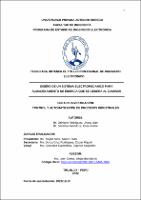Mostrar el registro sencillo del ítem
Diiseño de un sistema electromecánico para almacenamiento de energía que se genera al caminar
| dc.contributor.advisor | León Cerna, Alejandro Martin | |
| dc.contributor.author | Otiniano Rodríguez, Jhony Iván | |
| dc.contributor.author | Sánchez Mendoza, Enzo Andre | |
| dc.creator | Otiniano Rodríguez, Jhony Iván | |
| dc.date.accessioned | 2023-01-19T16:23:51Z | |
| dc.date.available | 2023-01-19T16:23:51Z | |
| dc.date.issued | 2023 | |
| dc.identifier.uri | https://hdl.handle.net/20.500.12759/10139 | |
| dc.description.abstract | El presente informe de investigación tuvo como objetivo almacenar la energía eléctrica de un sistema electromecánico formado por una baldosa y generador eléctrico tipo dínamo para convertir energía potencial que se genera al caminar en energía eléctrica, esto se dio por medio del efecto piezoeléctrico el cual tiene la función de convertir la energía mecánica de un objeto con masa en energía eléctrica renovable. El tipo de investigación fue aplicada y de nivel explicativo, debido a que trato de explicar las causas en distintas etapas del estudio, originando secuencias de causa y efecto, y el diseño de la investigación fue experimental. En los resultados podemos observar que se logró diseñar una baldosa piezoeléctrica a partir de la evaluación de los parámetros de masa de 80kg, 66kg, 51kg, 34kg, 23kg. Así mismo se halló la energía mecánica y se obtuvo (0.132J, 0.093J, 0.0539J, 0.026J, 0.00741J), y por último se determinó el número de pisadas necesarias para encender un LED de 2.2v, siendo el número de pisadas de 1197 para una masa de 80kg generando 158.4J de energía renovable. | es_PE |
| dc.description.abstract | The objective of this research report was to store the electrical energy of an electromechanical system formed by a tile and a dynamo-type electric generator to convert potential energy that is generated when walking into electrical energy, this occurred through the piezoelectric effect which has the function of converting the mechanical energy of an object with mass into renewable electrical energy. The type of research was applied and explanatory level, because I try to explain the causes at different stages of the study, originating sequences of cause and effect, and the research design was experimental. In the results we can see that it was possible to design a piezoelectric tile from the evaluation of the mass parameters of 80kg, 66kg, 51kg, 34kg, 23kg. Likewise, the mechanical energy was found and obtained (0.132J, 0.093J, 0.0539J, 0.026J, 0.00741J), and finally the number of steps necessary to turn on a 2.2v LED was determined, being the number of steps of 1197 for a mass of 80kg generating 158.4J of renewable energy. | en_US |
| dc.description.uri | Tesis | es_PE |
| dc.format | application/pdf | es_PE |
| dc.language.iso | spa | es_PE |
| dc.publisher | Universidad Privada Antenor Orrego | es_PE |
| dc.relation.ispartofseries | T_ELECT_878 | |
| dc.rights | info:eu-repo/semantics/openAccess | es_PE |
| dc.rights.uri | https://creativecommons.org/licenses/by/4.0/ | es_PE |
| dc.source | Universidad Privada Antenor Orrego | es_PE |
| dc.source | Repositorio Institucional - UPAO | es_PE |
| dc.subject | Energía Renovable | es_PE |
| dc.subject | Baldosa Piezoelectrica | es_PE |
| dc.title | Diiseño de un sistema electromecánico para almacenamiento de energía que se genera al caminar | es_PE |
| dc.type | info:eu-repo/semantics/bachelorThesis | es_PE |
| thesis.degree.level | Título Profesional | es_PE |
| thesis.degree.grantor | Universidad Privada Antenor Orrego. Facultad de Ingeniería | es_PE |
| thesis.degree.name | Ingeniero Electrónico | es_PE |
| thesis.degree.discipline | Ingeniería Electrónica | es_PE |
| dc.subject.ocde | https://purl.org/pe-repo/ocde/ford#2.11.00 | es_PE |
| renati.advisor.orcid | https://orcid.org/0000-0001-5465-7866 | es_PE |
| renati.author.dni | 73948735 | |
| renati.author.dni | 70675439 | |
| renati.advisor.dni | 46431406 | |
| renati.type | https://purl.org/pe-repo/renati/type#tesis | es_PE |
| renati.level | https://purl.org/pe-repo/renati/level#tituloProfesional | es_PE |
| renati.discipline | 712026 | es_PE |
| renati.juror | Trujillo Silva, Marco Tulio | |
| renati.juror | De La Cruz Rodríguez, Oscar Miguel | |
| renati.juror | Gonzalez Cadenillas, Clayder Alejandro | |
| dc.publisher.country | PE | es_PE |
Ficheros en el ítem
Este ítem aparece en la(s) siguiente(s) colección(es)
-
Ingeniería Electrónica [146]


